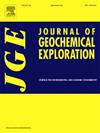The reduction process contributes to the generation of subduction-related Langmuri Cu-Ni sulfide deposits in the East Kunlun Orogen, Northern Tibetan Plateau
IF 3.3
2区 地球科学
Q1 GEOCHEMISTRY & GEOPHYSICS
引用次数: 0
Abstract
Ore-genesis of the subduction-related Cu-Ni sulfide deposits has not been well studied. This article focuses on the Langmuri Cu-Ni sulfide deposit in the East Kunlun Orogen (EKO) by studying the symbiotic ore-bearing olivine pyroxenite and ore-free gabbro. Twenty-seven Cu-Ni sulfide orebodies were defined in these ultramafic and mafic rocks in past years with Ni average grades up to 1.5 % and Cu average grades up to 0.18 %. The ore mineralization comprises sulfides (pyrite, chalcopyrite, pentlandite, and pyrrhotite) and oxides (chromite and magnetite). Zircon U-Pb dating shows that the Langmuri mafic-ultramafic rocks have similar emplacement ages (449.9 ± 3.9 Ma for the olivine pyroxenite, 450.8 ± 1.8 Ma for the gabbro), and they were generated during the northward subduction of the Proto-Tethys Ocean. These rocks were sourced from partial melting of a continuously enriched lithosphere mantle resulting from interaction with slab-derived fluids. The ore-bearing olivine pyroxenite had a basaltic parental magma. It underwent accumulation of olivine and minor chromite and crustal contamination during magmatic evolution, while the ore-free mafic rocks underwent fractional crystallization of olivine and chromite and the crustal contamination was insignificant. The oxidation state of the ore-bearing olivine pyroxenite at QFM-1 to QFM is lower than the values for normal arc magma and the ore-free gabbro, which should be associated with the crustal contamination. Based on these clues, we inferred that fractional crystallization of olivine and minor chromite occurred in a deep magmatic chamber, and these minerals accumulated locally to form olivine-rich ultramafic rocks. The magma that underwent fractional crystallization of these minerals is the parental magma for the ore-free gabbro, while the magma with accumulation of these minerals is heavier and transported more slowly, which makes it undergo significant crustal contamination during magmatic rising. The crustal contamination reduced the magma, resulting in the sulfur saturation in magma and the generation of Cu-Ni sulfide orebodies in the Late Ordovician subduction setting at EKO.
青藏高原北部东昆仑造山带的还原作用形成了与俯冲有关的Langmuri铜镍硫化物矿床
与俯冲有关的铜镍硫化物矿床的成因尚未得到很好的研究。本文以东昆仑造山带Langmuri铜镍硫化物矿床为研究对象,对共生含矿橄榄辉石岩和无矿辉长岩进行了研究。近年来在这些超基性和基性岩石中确定了27个铜镍硫化物矿体,镍平均品位达1.5%,铜平均品位达0.18%。矿石矿化包括硫化物(黄铁矿、黄铜矿、镍黄铁矿和磁黄铁矿)和氧化物(铬铁矿和磁铁矿)。锆石U-Pb定年结果表明,Langmuri基性-超基性岩石具有相似的侵位年龄(橄榄辉石岩为449.9±3.9 Ma,辉长岩为450.8±1.8 Ma),形成于原特提斯洋向北俯冲期间。这些岩石来自于连续富集的岩石圈地幔与板块衍生流体相互作用的部分熔融。含矿橄榄辉石岩母岩浆为玄武岩。岩浆演化过程中经历了橄榄石和少量铬铁矿的富集和地壳污染,而无矿基性岩则经历了橄榄石和铬铁矿的分步结晶,地壳污染不明显。QFM-1 ~ QFM含矿橄榄辉石岩的氧化态低于正常弧岩浆和无矿辉长岩的氧化态,可能与地壳污染有关。根据这些线索,我们推测在深部岩浆室中存在橄榄石和少量铬铁矿的分异结晶,这些矿物在局部聚集形成富橄榄石的超镁铁质岩。这些矿物经过分离结晶的岩浆是无矿辉长岩的母岩浆,而这些矿物聚集的岩浆较重,运输较慢,在岩浆上升过程中受到明显的地壳污染。在晚奥陶世俯冲背景下,地壳污染降低了岩浆,导致岩浆中硫饱和,形成铜镍硫化物矿体。
本文章由计算机程序翻译,如有差异,请以英文原文为准。
求助全文
约1分钟内获得全文
求助全文
来源期刊

Journal of Geochemical Exploration
地学-地球化学与地球物理
CiteScore
7.40
自引率
7.70%
发文量
148
审稿时长
8.1 months
期刊介绍:
Journal of Geochemical Exploration is mostly dedicated to publication of original studies in exploration and environmental geochemistry and related topics.
Contributions considered of prevalent interest for the journal include researches based on the application of innovative methods to:
define the genesis and the evolution of mineral deposits including transfer of elements in large-scale mineralized areas.
analyze complex systems at the boundaries between bio-geochemistry, metal transport and mineral accumulation.
evaluate effects of historical mining activities on the surface environment.
trace pollutant sources and define their fate and transport models in the near-surface and surface environments involving solid, fluid and aerial matrices.
assess and quantify natural and technogenic radioactivity in the environment.
determine geochemical anomalies and set baseline reference values using compositional data analysis, multivariate statistics and geo-spatial analysis.
assess the impacts of anthropogenic contamination on ecosystems and human health at local and regional scale to prioritize and classify risks through deterministic and stochastic approaches.
Papers dedicated to the presentation of newly developed methods in analytical geochemistry to be applied in the field or in laboratory are also within the topics of interest for the journal.
 求助内容:
求助内容: 应助结果提醒方式:
应助结果提醒方式:


